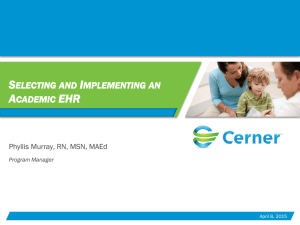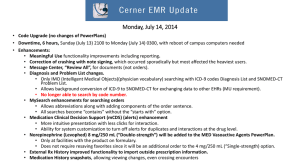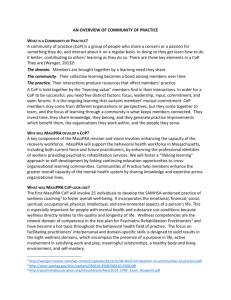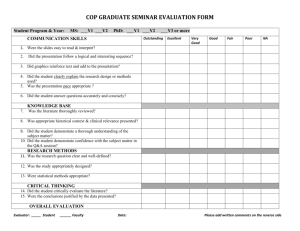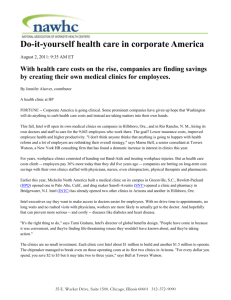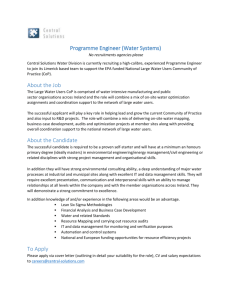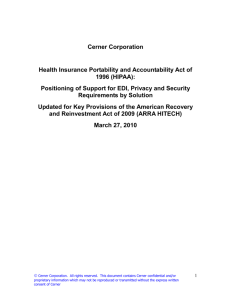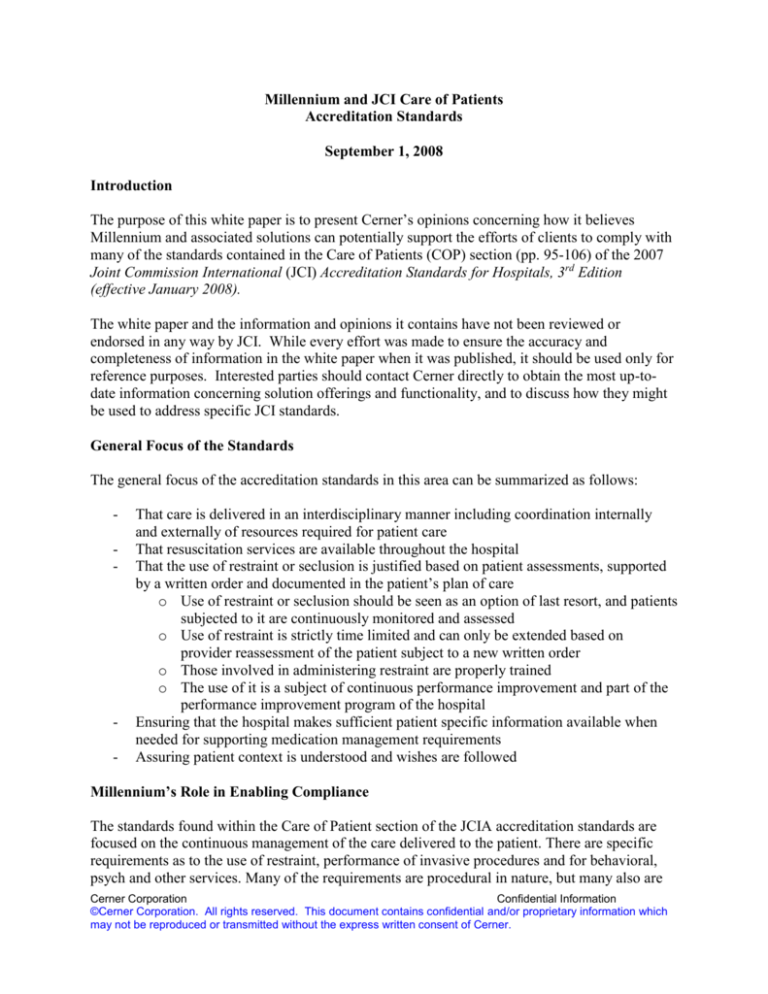
Millennium and JCI Care of Patients
Accreditation Standards
September 1, 2008
Introduction
The purpose of this white paper is to present Cerner’s opinions concerning how it believes
Millennium and associated solutions can potentially support the efforts of clients to comply with
many of the standards contained in the Care of Patients (COP) section (pp. 95-106) of the 2007
Joint Commission International (JCI) Accreditation Standards for Hospitals, 3rd Edition
(effective January 2008).
The white paper and the information and opinions it contains have not been reviewed or
endorsed in any way by JCI. While every effort was made to ensure the accuracy and
completeness of information in the white paper when it was published, it should be used only for
reference purposes. Interested parties should contact Cerner directly to obtain the most up-todate information concerning solution offerings and functionality, and to discuss how they might
be used to address specific JCI standards.
General Focus of the Standards
The general focus of the accreditation standards in this area can be summarized as follows:
-
-
That care is delivered in an interdisciplinary manner including coordination internally
and externally of resources required for patient care
That resuscitation services are available throughout the hospital
That the use of restraint or seclusion is justified based on patient assessments, supported
by a written order and documented in the patient’s plan of care
o Use of restraint or seclusion should be seen as an option of last resort, and patients
subjected to it are continuously monitored and assessed
o Use of restraint is strictly time limited and can only be extended based on
provider reassessment of the patient subject to a new written order
o Those involved in administering restraint are properly trained
o The use of it is a subject of continuous performance improvement and part of the
performance improvement program of the hospital
Ensuring that the hospital makes sufficient patient specific information available when
needed for supporting medication management requirements
Assuring patient context is understood and wishes are followed
Millennium’s Role in Enabling Compliance
The standards found within the Care of Patient section of the JCIA accreditation standards are
focused on the continuous management of the care delivered to the patient. There are specific
requirements as to the use of restraint, performance of invasive procedures and for behavioral,
psych and other services. Many of the requirements are procedural in nature, but many also are
Cerner Corporation
Confidential Information
©Cerner Corporation. All rights reserved. This document contains confidential and/or proprietary information which
may not be reproduced or transmitted without the express written consent of Cerner.
directly supported by different aspects of Millennium’s computerized prescriber order entry
(CPOE)/order management, nursing/physician documentation, clinical event and clinical
document viewing, pharmacy and other applications that support direct patient care.
The key Millennium solutions involved include:
-
Order Management
PowerPlans
CareNet Documentation Management
INet
eMAR
PowerPOC
Results review
Discern Expert
Patient Management
Patient Privacy
Note: The solutions, solution functionality, and services referenced in this white paper may not
be available in all markets.
At a more granular level, Millennium can assist in enabling compliance with these standards in
the ways described below. (Specific JCI accreditation standards are stated followed by the
abilities of Millennium to enable compliance.) The JCI standards that are highlighted for
comment are those that seem to most directly imply a system role in compliance.
Care Delivery for All Patients
COP.1 – Policies and procedures and applicable laws and regulations guide the uniform care of
all patients.
The organization’s leaders collaborate to provide uniform care processes. (Also see
ACC.1.1 and AOP.4, ME 1)
Policies and procedures guide uniform care and reflect relevant laws and regulations.
The system allows for definition of plans of care to assure similar care is provided to patients
of like condition and need.
COP.2 – There is a process to integrate and coordinate the care provided to each patient.
Care planning is integrated and coordinated among settings, departments and services.
(Also see ACC.2, ME 3)
Care delivery is integrated and coordinated among settings, departments and services.
The results or conclusion of any patient care team meetings or other collaborative
discussions are written in the patient’s record.
Cerner Corporation
Confidential Information
©Cerner Corporation. All rights reserved. This document contains confidential and/or proprietary information which
may not be reproduced or transmitted without the express written consent of Cerner.
The system uses the plan of care as a schedule of care related activities to be completed on
behalf of the patient. The activities can be performed by individuals acting in direct patient
care roles involved with patient care at particular care locations. The status of the care plan
for a patient can be viewed for management and oversight, and overdue activities followed
up on as needed. The plan of care can be used to coordinate the scheduling and performing
of diagnostic procedures, medication administration activities, surgical procedures and other
interventions. These can become part of the schedule of care based on the required
frequency, timing and duration of any scheduled events.
COP.2.1 – The care provided to each patient is planned and written in the patient’s record.
The care for each patient is planned by the responsible physician, nurse, and other health
professionals within 24 hours of admission as an inpatient.
The planned care is individualized and based on the patient’s initial assessment data.
The plan is updated or revised, as appropriate, based on the reassessment of the patient
by the care providers.
The care planned for each patient is written in the patient’s record.
The planned care is provided.
The care provided for each patient is written in the patient’s record. (Also see ASC.7.2;
ASC.5.2, ME 1; and COP.2.3, ME 1)
See previous response. The plan of care is documented in the patient’s record and its
execution is initiated by associating the plan to the patient’s record. The execution of the
plan initiates the scheduling and creation of tasks and orders to be performed in the
appropriate sequence for the patient’s care. As care activities are completed, their
completion can be documented in the patient’s record through the appropriate mechanism
(e.g., through charting of nursing tasks, through documenting medication administration
events in the patient’s medication administration record, etc).
The system can support a suggested plan of care based on the assessment results from
the admission assessment.
For direct patient care, the system can support definition of templates for plans of care for a
given diagnosis or a particular type of outcome. The plan can include particular phases to
organize care activities into the different stages of the plan as appropriate. Time frames can
be defined to manage the proper sequencing and implementation of the care plan. Patient
outcomes can be documented against the plan. The system can support a merged view of the
plan that performs duplicate checking as of the time of assignment/activation to prevent a
duplication of activities within the same span of time. The system supports definition of the
above elements of a care plan, and the care plan can be maintained as a living plan based on
changes in patient condition.
COP.2.2 – Those permitted to write patient orders write the order in the patient record in a
uniform location.
Cerner Corporation
Confidential Information
©Cerner Corporation. All rights reserved. This document contains confidential and/or proprietary information which
may not be reproduced or transmitted without the express written consent of Cerner.
Orders are written when required and follow organization policy. (Also see MMU.4)
Diagnostic imaging and clinical laboratory test orders include a clinical
indication/rationale when required for interpretation.
Only those permitted to write orders do so.
Orders are found in a uniform location in patient records.
The plan of care may lay out the scheduled time frame for the activation of orders or orders
may be entered as per the written physician order at the appropriate times required.
Clinicians must have appropriate security privileges within the system to be able to place
orders and to be able to verify, perform and complete orders. Orders are found documented
within a consistent place accessible in the patient’s electronic medical record presented on a
common “tab” for inquiry purposes.
COP.2.3 – Procedures performed are written into the patient’s record.
Procedures performed are written into the patient’s record.
The results of procedures performed are written into the patient’s record.
As procedures are performed, the system can enable the documentation of the results of the
procedures whether through clinical documentation or reports entered as narrative text, a
combination of text and discrete data or as discrete data alone (e.g., lab values). The identity
of the individuals performing and verifying the results is captured as these activities are
conducted.
COP.2.4 – Patients and families are informed about the outcomes of care and treatment including
unanticipated outcomes.
Patients and families are informed about the outcomes of their care and treatment. (Also
see PFR.2.1.1, ME 1)
Patients and families are informed about any unanticipated outcomes of their care and
treatment. (Also see PFR.2.1.1, ME 2)
The system can support planning for post discharge care through support of documentation,
and for reporting on active medications at time of discharge (medication reconciliation
project). The system can support communication of care summaries and activities as of the
time of discharge, and Medical Record Publishing (MRP) can be used for output if the
transferred to provider is not also a user. Support for the generation and transmission of
standards based (e.g., HL7 CDA R2) document types for communication of structured
electronic clinical documents for discharge.
In Millennium 2007, the system supports generation of discharge instructions both to the
provider and to the patient in a common manner across different settings of care. For the
patient version of the discharge summary, the system supports use of third party content to
provide educational or instructional information in a manner to the appropriate the reading
level of the patient, and relative to the patient condition. The ability to generate such
Cerner Corporation
Confidential Information
©Cerner Corporation. All rights reserved. This document contains confidential and/or proprietary information which
may not be reproduced or transmitted without the express written consent of Cerner.
materials is limited to self administered medication instructions and to post care instructions
provided as a part of post operative, post procedure or discharge instructions that may be
documented to be given to the patient as a part of the clinical documentation recorded in the
patient’s electronic record. Clinical staff typically uses the system to document the fact that
patient education activities occurred associated to options for treatment. This can be done in
a variety of ways depending on the situation – for example, through PowerForm or Clinical
Note entries (for care planning related education or discussions), through technologist
comments (for RadNet and education provided relative to diagnostic imaging) and through
surgical documentation (for discussion of surgical procedures and options).
Care of High Risk Patients and Provision of High Risk Services
COP.3 – Policies and procedures guide the care of high risk patients and the provision of highrisk services.
The organization’s leaders have identified the high-risk patients and services.
The leaders use a collaborative process to develop applicable policies and procedures.
Staff have been trained and use the policies and procedures to guide care.
See responses below for more information on system role in supporting care of high-risk
patients.
COP.3.1 – Policies and procedures guide the care of emergency patients.
The care of emergency patients is guided by appropriate policies and procedures.
Patients receive care consistent with the policies and procedures.
The system enables the triage assessment process through documentation forms for
emergency patients, and supports the activities related to order management, medication
management, registration, tracking of diagnostic orders and the documentation of
therapeutic/invasive through specific system capabilities within the FirstNet emergency
department solution.
COP.3.2 – Policies and procedures guide the use of resuscitation services throughout the
organization.
The uniform use of resuscitation services throughout the organization is guided by
appropriate policies and procedures.
Resuscitation is provided according to policies and procedures.
The system does not play a direct role in support of resuscitation services aside from
supporting documentation of its use for a given patient.
COP.3.3 – Policies and procedures guide the handling, use and administration of blood and
blood products.
Cerner Corporation
Confidential Information
©Cerner Corporation. All rights reserved. This document contains confidential and/or proprietary information which
may not be reproduced or transmitted without the express written consent of Cerner.
The handling, use, and administration of blood and blood products is guided by
appropriate policies and procedures.
Blood and blood products are administered according to policies and procedures.
Millennium generally supports the use of two identifiers for purposes of patient identification
for support blood product administration. For specimen collection of blood specimens, the
system supports display of the patient name in response to the bar code read, and supports the
bar coding of either MRN or financial number.
On transfusion tags, the system supports printing patient name, MRN, financial number, or
SSN on the tag itself.
System capability is available through Millennium’s Blood Bank Transfusion module to
address proper identification, handling, inventorying, and management of blood and blood
products used for administration. Within SurgiNet, the amount of blood transfused may be
documented as a part of the surgical documentation captured within the system.
To the extent that blood and blood components are drawn from the patient or administered to
the patient, the system can support capture of these activities and the responsibility for these
activities.
COP.3.4 – Policies and procedures guide the care of patients on life support or who are
comatose.
The care of comatose patients is guided by appropriate policies and procedures.
The care of patients who are on life support is guided by policies and procedures.
Comatose patients and patients on life support receive care according to the policies and
procedures.
To the extent the system supports the care provided for such patients, it is in a similar manner
to that for other patients (e.g., assignment of plan of care appropriate to the patient’s
condition as a special needs patient, development of specific assessment forms for
assessment/reassessment, order management, scheduling management, documentation
management, medication management, diagnostic procedure result entry, and reporting, etc).
Concerning advanced directives: an assessment form can be used (in part or in whole) to
document the presence of an advanced directive. If a PowerForm is used in this way, the
advance directive is accessible to the care team in the Advanced Directive section of the Gen
View. This is the most effective way to document the presence of the advanced directive in a
manner accessible to the care team. Alternatively, the system can support the capture of
advanced directives as scanned documents from offline forms or as generated as paper based
forms which are signed and scanned and associated to the encounter or the person or as
electronic forms as described above. The presence of an advanced directive on file can also
be indicated through a registration field defined by a provider to be used for that purpose. In
Cerner Corporation
Confidential Information
©Cerner Corporation. All rights reserved. This document contains confidential and/or proprietary information which
may not be reproduced or transmitted without the express written consent of Cerner.
the ED, FirstNet supports use of PowerForms to collect Advance Directives as other
solutions do. Other forms of patient rights notices pamphlets are usually administered on
paper, but may be put into discharge instructions if appropriate for inclusion in information
given to the patient at that time. For mental health patients, the system also supports
documentation of a psychiatric advance directive as an individual form or as a section of a
more comprehensive form as supported by the PowerForm discussed above.
COP.3.5 – Policies and procedures guide the care of patients with a communicable disease and
immune suppressed patients.
The care of patients with a communicable disease is guided by appropriate policies and
procedures.
The care of immune-suppressed patients is guided by appropriate policies and
procedures.
Immune-suppressed and patients with communicable diseases receive care according to
the policies and procedures.
See previous response.
COP.3.6 – Policies and procedures guide the care of patients on dialysis.
The care of patients on dialysis is guided by appropriate policies and procedures.
Dialysis patients receive care according to the policies and procedures.
See previous response – in particular, documentation of the results of blood glucose
monitoring and recording of insulin injections and diet patterns may be specialized elements
of documentation supported through the system.
COP.3.7 – Policies and procedures guide use of restraint and the care of patients in restraint.
The use of restraint is guided by appropriate policies and procedures.
Patients in restraint receive care according to the policies and procedures.
The system supports order/task/documentation of restraint use. The time periods for reassessment and provider notification can be supported to the extent the original order
duration drives provider notification and further assessments drive the necessity for
determining reuse of restraints. Discern Expert can further assist with decision support
and/or automation of order/task/documentation
Cerner’s recommended content includes guidelines for assessment, criteria for applying
restraint, criteria for monitoring/reassessment and criteria for terminating restraint. The order
set for medical restraint includes support for generating monitoring tasks to be timed every
two hours. The system can support capture of the documentation required for the use of
restraint using recommended content through assessment and other appropriate
documentation forms.
Cerner Corporation
Confidential Information
©Cerner Corporation. All rights reserved. This document contains confidential and/or proprietary information which
may not be reproduced or transmitted without the express written consent of Cerner.
COP.3.8 – Policies and procedures guide the care of elderly patients, disabled individuals,
children, and populations at risk for abuse.
The care of frail, dependent elderly patients is guided by appropriate policies and
procedures.
Frail, dependent elderly patients receive care according to the policies and procedures.
The care of young, dependent children is guided by appropriate policies and procedures.
Young, dependent children receive care according to the policies and procedures.
Patient populations at risk for abuse are identified and their care is guided by
appropriate policies and procedures.
Identified populations at risk for abuse receive care according to the policies and
procedures.
See sections in the white paper Millennium and JCI Assessment of Patients for information
on how the system can support assessment requirements of such patients. Otherwise, care
plans can be developed and assigned specific to such patients’ needs to address such matters
as increased risk of falls, special considerations for medication management and other
matters.
COP.3.9 – Policies and procedures guide the care of patients receiving chemotherapy or other
high-risk medications.
The care of patients receiving chemotherapy or other high-risk medications is guided by
appropriate policies and procedures.
Patients receiving chemotherapy or other high-risk medications receive care according
to the policies and procedures.
Millennium supports the administration of high risk medications, such as insulin. Chemotherapy
has a more in-depth verification process that today can be captured by a PowerForm. Starting
with the physician, (sometimes two physicians), the nurse checks the order through the nurse
verification process, the pharmacist then verifies the order and finally the administering nurse
has a verification process they follow that is captured in the PowerForm. This verification
process will vary from client to client depending on how the verification processes are built.
Future development plans are in place to enhance this process. Millennium has current
functionality using rules, alerts and forms to meet the requirements.
The system can support documentation of sedation/anesthesia administration in surgical
documentation. The system can support documentation of monitoring activities during the
procedure in the same documentation. This can be done through telemetry interfaces with the
medical devices if available, but the actual continuous posting of the telemetry is usually outside
the scope of system use.
Food and Nutrition Therapy
Cerner Corporation
Confidential Information
©Cerner Corporation. All rights reserved. This document contains confidential and/or proprietary information which
may not be reproduced or transmitted without the express written consent of Cerner.
COP.4 – A variety of food choices, appropriate for the patient’s nutritional status and consistent
with his/her clinical care, is regularly available.
Food, appropriate to the patient, is regularly available.
All patients have an order for food in their record.
The order is based on the patient’s nutritional status and needs.
Patients have a variety of food choices consistent with their condition and care.
When families provide food, they are educated about the patient’s diet limitations.
Aside from supporting a nutritional assessment, the placement of nutritional orders and the
documentation of nutrition if appropriate to the patient’s plan of care, the system does not
provide support for nutrition management.
COP.4.1 – Food preparation, handling, storage, and distribution are safe and comply with laws,
regulations, and current acceptable practices.
Food is prepared in a manner that reduces risk of contamination and spoilage.
Food is stored in a manner that reduces risk of contamination and spoilage.
Enteral nutrition products are stored according to manufacturer recommendations and
organization policy.
The distribution of food is timely and special requests are met.
Practices meet applicable laws, regulations, and acceptable practices.
See COP.4.
COP.5 – Patients at nutrition risk receive nutrition therapy.
Patients assessed at nutrition risk receive nutrition therapy.
A collaborative process is used to plan, deliver, and monitor nutrition therapy. (Also see
COP.2)
The patient’s response to nutrition therapy is monitored. (Also see AOP.2, ME 1)
The patient’s response to nutrition therapy is recorded in his or her record. (Also see
MCI.19.2, ME 4)
The system enables capture of the nutrition assessment, and can support the inclusion of
nutrition therapy orders as a part of a plan of care.
Pain Management and End of Life Care
COP.6 – Patients are supported in managing pain effectively.
Based on the scope of services provided, the organization has processes to identify
patients in pain. (Also see AOP.1.8.2, ME 1)
Patients in pain receive care according to pain management guidelines.
Cerner Corporation
Confidential Information
©Cerner Corporation. All rights reserved. This document contains confidential and/or proprietary information which
may not be reproduced or transmitted without the express written consent of Cerner.
Based on the scope of services provided, the organization has processes to communicate
with and educate patients and families about pain. (Also see PFE.4, ME 5)
Based on the scope of services provided, the organization has processes to educate staff
about pain. (Also see SQE.3, ME 1)
The system supports the definition and documentation of the pain assessment through a form.
Further, the eMAR can facilitate re-tasking the nurse at defined time criteria to assess the
patient’s pain level after administering PRN pain management medications.
The system enables the capture of pain management information through appropriate
assessment formats; the system also enables documentation of any patient education on pain
management that may have occurred. System enables the definition of pain management
activities within the framework of appropriate plans of care including the ordering and
execution of any pain management protocols that also allow for tracking of exception
conditions through variance from protocols. The system also supports documentation of
monitoring activities for patient responses to pain management medications such as those
initiated post operatively in surgical areas.
COP.7 – The organization addresses end of life care.
Staff are made aware of patients’ unique needs at the end of life.
End-of-life care provided by the organization addresses dying patients’ needs at least
including elements a) through e) in the intent statement as appropriate to the patient and
family.
[NOTE: The following section is from the intent statement.]
Care provided by the organization includes:
a) Providing appropriate treatment for any symptoms according to the wishes of the
patient and family;
b) Sensitively addressing issues such as autopsy and organ donation;
c) Respecting the patient’s values, religion, and cultural preferences;
d) Involving the patient and family in all aspects of care; and
e) Responding to the psychological, emotional, spiritual, and cultural concerns of the
patient and family.
See PFR.2.3 in the white paper Millennium and JCI Patient and Family Rights Standards.
COP.7.1 – As appropriate to the care and services provided, assessments and reassessments of
the dying patient and their family are designed to meet individualized needs.
Patients and families are assessed and reassessed at least for those elements identified in
a) through i) in the intent statement, as appropriate.
[NOTE: The elements in the intent statement are too lengthy to include here.]
Assessment findings guide the care and services provided.
Cerner Corporation
Confidential Information
©Cerner Corporation. All rights reserved. This document contains confidential and/or proprietary information which
may not be reproduced or transmitted without the express written consent of Cerner.
The system enables assessment and reassessment processes in a similar manner to other
forms of assessment and reassessment. These capabilities are discussed further previously in
this white paper.
COP.7.2 – Care of the dying patient optimizes his or her comfort and dignity.
Interventions are taken to manage pain and primary or secondary symptoms. (Also see
PFR.2.4, ME 1)
Symptoms are prevented to the extent reasonably possible.
Interventions address patient and family psychosocial, emotional and spiritual needs
regarding dying and grieving.
Interventions address patient and family religious and cultural concerns.
The patient and family are involved in care decisions. (Also see PFR.2, ME 1 and
PFR.2.1, ME 4)
See Millennium and JCI Patient and Family Rights Standards white paper concerning patient
advance directives and communication of such directives. The system can enable the
definition and assignment to the patient’s overall plan of care of plans of care for pain
management and end of life care as may be required.
Cerner Corporation
Confidential Information
©Cerner Corporation. All rights reserved. This document contains confidential and/or proprietary information which
may not be reproduced or transmitted without the express written consent of Cerner.


